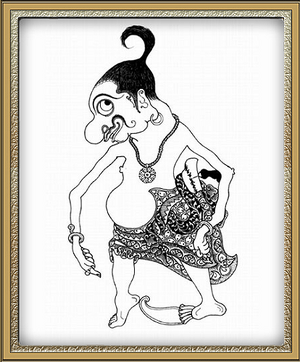Gareng - (Wayang Kulit)
| Title | Gareng - (Panakawan) - All stories |
|---|---|
| Other names | Bambang Sukskati, Garingan, Pandu Bregala, Pecukilan, Pancalpamor which means rejecting worldly temptations, |
| Size | 40 cm |
| Personal data | Gareng or Nala Gareng is the oldest son of Semar. His two other brothers are named Petruk, and Bagong. Together they are called the Panakawan. Gareng comes from puja, meaning what is obtained through worship. Nala Gareng married Dewi Sariwati, the daughter of Prabu Sarawasesa with the consort Dewi Saradewati from the country of Salarengka, which he obtained with the help of Resi Tritusta from the country of Purwadukna. Nala Gareng lived a very long life, he lived until the Middle Ages. |
| Appearance | Gareng is handicapped, he has one arm shorter than the other and a lame leg which symbolizes Gareng's nature as a subject who is always careful in his actions. He has a round nose and his hands are ciker/czech or broken, which symbolizes that he doesn't like taking other people's rights. His eyes are crossed, symbolizing that Gareng doesn't want to see things that invite evil or things that are not good. Gareng wears a necklace, pigtails and a crew cloth (Javanese: Dhagelan). Gareng is stupid and always pessimistic. He is often the victim of the pranks his brother Petruk plays. |
| Collection | Private collection |
Gareng – (Panakawan) – All stories
In the wayang golek purwa the Panakawan are: Semar, Petruk, Gareng and Cepot. The Panakawan are the servants of the 'good' heroes. They appear in all wayang stories and are a Javanese addition to the original stories. They are the only ones in the wayang game who do not have to stick to their text and are allowed to comment on everyday things and a little on politics.
The Panakawan speak plain Javanese and provide social reflection of the performance. As a result, the greatest innovations in wajang take place in the clown scenes. For example, contemporary music forms and new dramatic techniques can be used in these scenes. There may also be guest appearances by (pop) stars in the clown scenes.
The four clown servants (Panakawan) usually appear during patet sanga (second part of traditional Shadow puppet performance) accompanying one of the five Pandhawa brothers (in the Mahabharata epic), or accompanying Laksmana, Rama, Hanoman, or Jaya Premuja in the Ramayana epic. In the contemporary performance the Panakawan sometimes appear in patet nem (first part in an all-night shadow puppet show). Some examples of stories where Panakawan appear in patet nem are Semar Mbangun Taman Kembang Sore (Semar builds a garden Kembang Sore), Semar Mbangun Kayangan (Semar build heaven), Petruk dadi Ratu (Petruk becomes a king).
Gareng was originally called Bambang Sukskati, son of Resi Sukskadi from the Bluluktiba hermitage. Bambang Sukskati meditated on Candala Hill for years to acquire supernatural powers. After completing his meditation, he asked his father for permission to conquer kings. In the middle of the journey Bambang Sukskati met Bambang Panyukilan, the son of Bagawan Salantara from the Kembangsore hermitage.
Because they were both arrogant and both defended their positions, a war broke out between the two. They had equal supernatural powers, so that no one lost or won. They also wouldn't stop fighting even though their bodies were disfigured by each other. The fight only ended after Semar (Sanghyang Ismaya) separated them.
Due to Sanghyang Ismaya's words, the two's shapes changed and became very ugly, and Bambang Sukskati's body became disabled. His eyes are cross-eyed, round nose, no neck, big belly, weak legs, crooked hands/tekle/Czech (Javanese). Batara Ismaya (Semar) is the guardian of the Pandava knights, in the form of Jangganan Samara Anta, he gives advice to both of them. Amazed by Batara Ismaya's advice, the two knights asked to serve and asked to be adopted as children. Finally, they were adopted as sons on the condition that they would accompany Batara Ismaya (Semar) to become the guardians of the Pandava knights.
Sanghyang Ismaya changed Sukskati’s name to Nala Gareng, while Bambang Panyukilan became Petruk.
Nalagareng means a dry heart, because he is a person who is not good at talking. What he says is wrong and he does not want to admit that he is wrong. Gareng was once a king in Paranggumiwang, named Pandubergola. He was appointed by Dewi Wara Sumbadra who at that time became the King of Paranggumiwang. The appointment of Gareng as king was actually to trick the Pendawa relatives, so that they did not know where Sumbadra lived. But finally Gareng was found by Petruk and he returned to being Gareng.
Petruk, Gareng and Semar never separated and always followed Raden Arjuna and his descendants.
Source: History of Wayang Purwa - Hardjowirogo - PN Balai Pustaka – 1982
Blog: Hadisukirno – Yogyakarta – 2011


